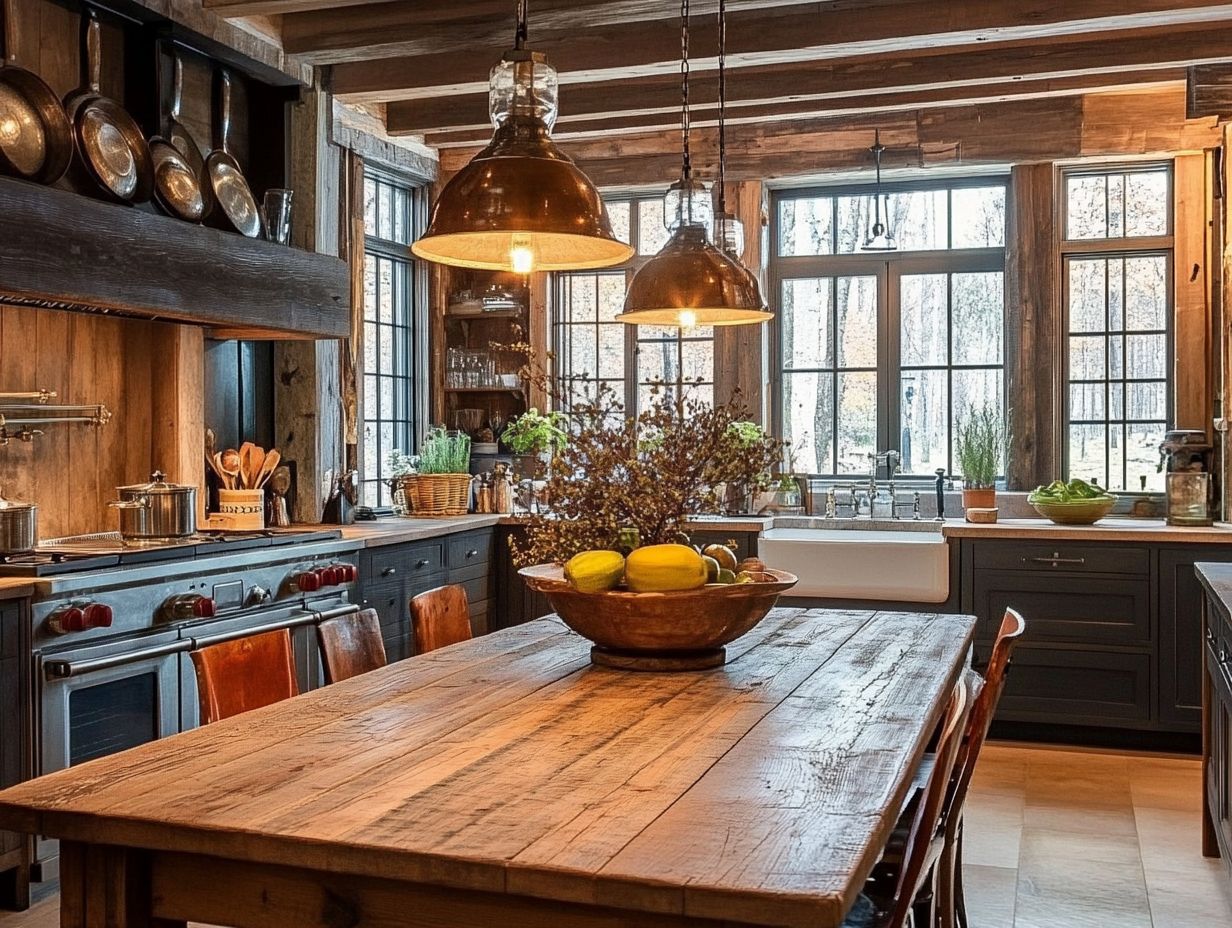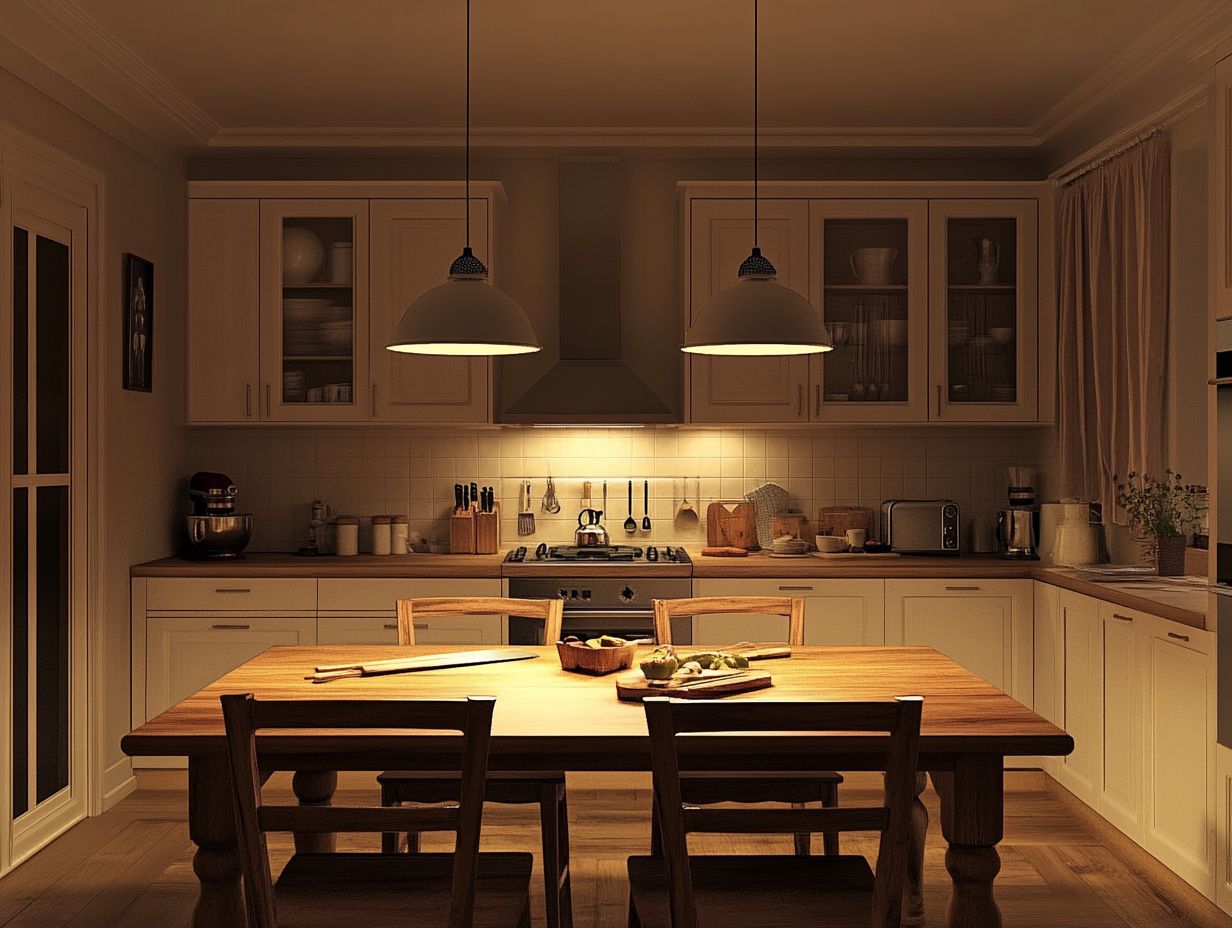How to Create a Warm Atmosphere with Kitchen Lighting
The kitchen serves as the heart of your home, and the right lighting can elevate it into a warm and functional sanctuary.
Understanding kitchen lighting is essential for any homeowner as it enhances mood and boosts efficiency. This exploration delves into the various types of lighting—overhead, task, and accent options—and guides you in selecting the perfect fixtures for your space.
You’ll discover how to craft a cozy atmosphere with warm light, along with practical tips for illuminating different kitchen areas effectively.
Get ready to turn your kitchen into a dazzling culinary haven!
Contents
- Key Takeaways:
- Understanding the Importance of Kitchen Lighting
- Types of Kitchen Lighting
- Choosing the Right Lighting Fixtures
- Creating a Warm Atmosphere with Lighting
- Tips for Properly Lighting Different Kitchen Areas
- Preguntas Frecuentes
- ¿Cómo puedo crear una atmósfera cálida en mi cocina usando iluminación?
- ¿Qué tipo de iluminación debo usar para crear una atmósfera cálida en mi cocina?
- ¿Puedo usar color para crear una atmósfera cálida con la iluminación de la cocina?
- ¿Cómo puedo usar la iluminación para crear un punto focal en mi cocina?
- ¿Cuáles son algunas formas de agregar calidez a mi cocina además de la iluminación?
- ¿Cómo puedo asegurarme de que la iluminación de mi cocina sea eficiente en energía mientras crea una atmósfera cálida?
Key Takeaways:

- Proper kitchen lighting boosts functionality and mood.
- Layer lighting types for a warm, inviting space.
- Choose fixtures that fit your kitchen’s style and size.
Understanding the Importance of Kitchen Lighting
The importance of kitchen lighting goes beyond visibility; it’s about crafting a warm ambiance that enhances well-being and functionality.
Experts like Maude Rondeau from Luminaire Authentik highlight that effective lighting can transform your kitchen into a welcoming haven for family gatherings.
By thoughtfully integrating the right fixtures and technologies, such as LED lights and dimmers, you can blend aesthetics with utility, turning your kitchen into an inviting area.
Impact on Mood and Functionality
Lighting shapes the mood and functionality of your kitchen, influencing how you perceive the space and engage within it during family gatherings or daily routines.
With the right design, you can transition from bright task lighting for food prep to soft, warm tones that invite conversation and connection.
Warm lighting, achieved through fixtures like pendant lights or recessed lights, creates a cozy atmosphere perfect for relaxation and bonding.
Dimmable options give you control over the ambiance, allowing you to set the perfect mood for intimate dinners or lively weekday breakfasts.
Types of Kitchen Lighting
The various types of kitchen lighting—general, task, accent, and decorative—each fulfill unique roles that elevate both functionality and aesthetic charm in your culinary space.
Overhead Lighting
Overhead lighting is the backbone of your kitchen’s illumination, providing essential general lighting that ensures the space remains functional and visually appealing.
This vital component enhances visibility, setting the stage for various activities, whether you’re preparing a meal or entertaining guests.
You have an array of fixture options, such as recessed lights and pendant lights, to create a unique atmosphere tailored to your individual taste and needs.
Recessed lights blend seamlessly into ceilings, delivering a sleek appearance while efficiently dispersing light. Pendant lights can infuse style and personality, acting as both lighting and decorative elements above your kitchen island or dining area.
By harmoniously blending these options, you can elevate your kitchen environment, transforming it into a space that is both practical and inviting.
Task Lighting

Task lighting is vital in your kitchen. It focuses on specific areas to improve safety and function while cooking.
Consider integrating well-placed fixtures like under-cabinet lights or adjustable pendant lamps. These can make it easier to see your countertops for tasks such as slicing vegetables or measuring ingredients.
Not only do these options help save energy, but they also create a focused lighting environment without flooding the entire space.
For your cabinetry, strategically positioned lights built into the ceiling or spotlights can accentuate shelves and storage areas. This makes navigation a breeze and significantly reduces the risk of accidents.
Choosing LED lights, which are energy-efficient bulbs that last longer and produce less heat, further improves safety by creating a comfortable cooking environment.
Accent Lighting
Accent lighting transforms your kitchen into a stunning space! It highlights architectural features and decorative elements to create an inviting ambiance.
Imagine under-cabinet LED strips illuminating your countertops, showcasing beautiful marble or granite surfaces while casting a cozy, warm glow during evening gatherings. Pendant lights with unique shades or artistic designs can act as focal points, drawing attention to your island or dining area.
By strategically placing spotlights or recessed lighting above artwork or open shelving, you enhance the kitchen’s features, wrapping the space in a warm, welcoming atmosphere that encourages both cooking and conversation.
Choosing the Right Lighting Fixtures
Choosing the right lighting fixtures for your kitchen is a pivotal decision that greatly influences both functionality and aesthetics.
It’s essential to ensure the space remains practical while also showcasing your unique personal style.
Considerations for Size, Style, and Location
When selecting lighting fixtures for your kitchen, it’s vital to consider size, style, and placement to achieve both functionality and design harmony. The right combination can dramatically enhance the space’s aesthetic appeal and practicality.
In smaller kitchens, for example, opting for compact pendant lights or recessed fixtures can create the illusion of spaciousness while providing essential illumination.
On the other hand, if you have a larger, open-concept kitchen, bold chandeliers or extensive track lighting can help define various areas and add character. The choice between warm or cool light tones can also impact the mood and overall perception of the space, fostering a welcoming atmosphere perfect for cooking and socializing.
By paying attention to these key elements, you can create a cohesive look that beautifully complements your overall decor.
Creating a Warm Atmosphere with Lighting
Choose your lighting wisely; it’s the key to a warm and inviting kitchen! Creating a warm atmosphere relies heavily on your lighting choices.
Pay attention to color temperature and how you incorporate natural light; these elements work together to cultivate a cozy environment that’s ideal for family gatherings.
Using Warm and Natural Light

Incorporating warm and natural light into your kitchen design not only elevates the atmosphere but also has a profound impact on your mood and overall well-being.
By creating a space that welcomes ample sunlight, you can cultivate an uplifting environment, perfect for family gatherings or entertaining guests.
Carefully placed windows and skylights play a crucial role in light flow. Choosing larger or multiple windows on the south-facing side ensures you maximize sunlight exposure throughout the day.
Adding reflective surfaces, such as light-colored cabinetry and countertops, can enhance this effect, making the kitchen feel brighter and more spacious.
Experimenting with window treatments like sheer curtains can further soften the light, helping you achieve that cozy yet vibrant kitchen vibe you desire.
Layering Lighting for a Cozy Effect
Layering lighting in your kitchen creates a cozy atmosphere by blending ambient, task, and accent lighting to form a well-rounded environment. This technique allows you to illuminate different areas of the kitchen according to their specific functions, ensuring beauty and efficiency.
For example, ambient lighting sets the overall mood and is typically achieved with ceiling fixtures or recessed lights that cast a warm glow throughout the space.
Task lighting is essential over work zones like countertops and sinks. Focused fixtures, such as pendant lights or under-cabinet lighting, enhance safety and enjoyment during meal prep.
Adding accent lighting—like illuminated shelves or decorative sconces—highlights architectural features and brings personality to your kitchen, making it a central gathering space.
Striking a balance among these three types of lighting creates an inviting kitchen environment, perfect for cooking, entertaining, and cherishing family moments.
Tips for Properly Lighting Different Kitchen Areas
Properly lighting various areas of your kitchen, from countertops to dining spaces, is crucial for enhancing functionality and ensuring each zone serves its intended purpose.
Countertops and Workspaces
Effective task lighting over your countertops and workspaces is essential for safe food preparation and cooking. It provides optimal visibility and comfort while you work.
When considering the best practices for kitchen lighting, choosing the right fixtures enhances functionality.
- Adjustable recessed lights offer broad illumination. Under-cabinet fixtures focus precisely on your countertops, perfect for intricate tasks like chopping and measuring.
- Pendant lights introduce a stylish flair while delivering targeted light for cooking areas.
- Varying the heights of fixtures helps eliminate shadows, ensuring every corner is brilliantly lit.
Incorporating dimming options gives you the flexibility to adjust lighting for different cooking activities, creating the ideal ambiance without compromising visibility.
Dining and Gathering Spaces
Creating an inviting ambiance in your dining and gathering spaces within the kitchen is crucial for fostering connection and enjoyment during meals. The right lighting can elevate the overall aesthetics, making it easier for your guests to engage in meaningful conversations while enjoying their culinary experience.
To achieve this effect, consider incorporating warm-toned fixtures, such as pendant lights above your dining table or strategically placed floor lamps in the corners. Dimmers can be invaluable, allowing you to adjust the brightness to set the perfect mood for any occasion—whether a casual family dinner or a lively celebration with friends.
By using layered lighting—ambient, task, and accent—you ensure that every corner of your space feels welcoming, fostering a sense of togetherness and warmth that enhances every gathering.
Preguntas Frecuentes

¿Cómo puedo crear una atmósfera cálida en mi cocina usando iluminación?
Para crear una atmósfera cálida en tu cocina, elige bombillas de temperatura cálida, como las de luz blanca suave o blanca cálida. Evita las bombillas de temperatura fría, como la de luz diurna o blanca fría. También puedes incorporar luces regulables para ajustar el nivel de brillo y añadir calidez al espacio.
¿Qué tipo de iluminación debo usar para crear una atmósfera cálida en mi cocina?
Para una atmósfera cálida, usa una combinación de iluminación general, de tarea y de acento. La iluminación general, como las luces empotradas o colgantes, proporciona luz general. La iluminación de tarea, como las luces debajo de los gabinetes, añade calidez a áreas específicas. La iluminación de acento, como apliques de pared o tiras LED, también puede aportar un ambiente acogedor al espacio.
Transforma tu cocina en un espacio cálido y acogedor hoy mismo. Para más opciones de iluminación, consulta a un profesional para obtener asesoramiento personalizado.
¿Puedo usar color para crear una atmósfera cálida con la iluminación de la cocina?
Sí, puedes usar color para realzar la calidez de la iluminación de tu cocina. Los colores cálidos como el rojo, el naranja y el amarillo crean una atmósfera acogedora y atractiva.
Incorpora estos colores a través de luces colgantes, pantallas de lámparas o en la pintura de tus paredes.
¿Cómo puedo usar la iluminación para crear un punto focal en mi cocina?
Utiliza una pieza llamativa, como una lámpara de araña o una luz colgante única, como el centro de atención. Combina diferentes niveles de iluminación para resaltar un área o característica específica en tu cocina.
¿Cuáles son algunas formas de agregar calidez a mi cocina además de la iluminación?
Incorpora elementos naturales, como madera o piedra, en el diseño de tu cocina. Usa colores y texturas cálidas, como acentos de cobre o alfombras tejidas, para un toque acogedor.
Agregar muebles suaves, como cojines decorativos o una alfombra acogedora, también ayudará a crear una atmósfera cálida.
¿Cómo puedo asegurarme de que la iluminación de mi cocina sea eficiente en energía mientras crea una atmósfera cálida?
Usa bombillas LED para hacer que la iluminación de tu cocina sea más eficiente. Estas bombillas consumen menos energía y duran más que las incandescentes tradicionales.
Instala interruptores reguladores para controlar el brillo y reducir el consumo de energía. Recuerda apagar las luces cuando no las necesites para conservar aún más energía.





